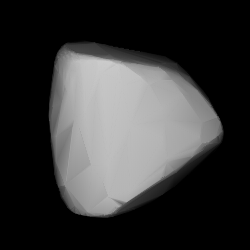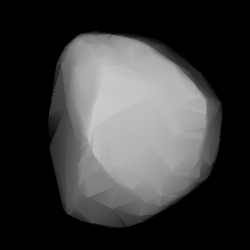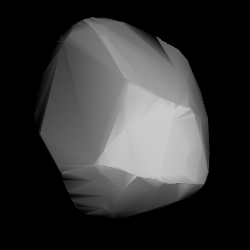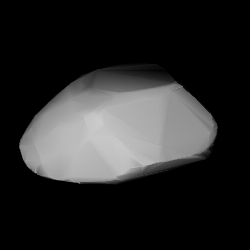
81 Terpsichore is a large and very dark main-belt asteroid. It has most probably a very primitive carbonaceous composition. It was found by the prolific comet discoverer Ernst Tempel on 30 September 1864. It is named after Terpsichore, the Muse of dance in Greek mythology.

99 Dike is a quite large and dark main-belt asteroid. Dike was discovered by Alphonse Borrelly on May 28, 1868. It was his first asteroid discovery. This object is named after Dike, the Greek goddess of moral justice. Among the first hundred numbered minor planets, 99 Dike was considered anomalously faint for over a century. However, this was later found to be untrue.

103 Hera is a moderately large main-belt asteroid with an orbital period of 4.44 years. It was discovered by Canadian-American astronomer James Craig Watson on September 7, 1868, and named after Hera, queen and fifth in power of the Olympian gods in Greek mythology. This is a stony S-type asteroid with a silicate surface composition.

149 Medusa is a bright-coloured, stony main-belt asteroid that was discovered by French astronomer J. Perrotin on September 21, 1875, and named after the Gorgon Medusa, a snake-haired monster in Greek mythology. It is orbiting the Sun at a distance of 2.17 AU with a period of 3.21 years and an eccentricity of 0.065. The orbital plane is tilted slightly at an angle of 0.94° to the plane of the ecliptic.

150 Nuwa is a large main-belt asteroid with an orbital period of 5.15 years. It was discovered by Canadian-American astronomer James Craig Watson on October 18, 1875, and named after Nüwa, the Chinese creator goddess. This object is a candidate member of the Hecuba group of asteroids that orbit near the 2:1 mean-motion resonance with Jupiter. Based upon the spectrum it is classified as a C-type asteroid, which indicates that it is probably composed of primitive carbonaceous chondritic material and the surface is exceedingly dark.

161 Athor is an M-type Main belt asteroid that was discovered by James Craig Watson on April 19, 1876, at the Detroit Observatory and named after Hathor, an Egyptian fertility goddess. It is the namesake of a proposed Athor asteroid family, estimated to be ~3 billion years old.

186 Celuta is a 50 km Main belt asteroid. It was discovered by the French astronomers Paul Henry and Prosper Henry on April 6, 1878. This was the last discovery credited to the Prosper brothers. It is classified as an S-type asteroid.

217 Eudora is a large Main belt asteroid. It was discovered by French (Corsican) astronomer J. Coggia on August 30, 1880, in Marseilles, France. It was his fourth asteroid discovery and is named after Eudora, a Hyad in Greek mythology.

224 Oceana is an asteroid from the asteroid belt. It was discovered by Austrian astronomer Johann Palisa on 30 March 1882, in Vienna. It was named after the Pacific Ocean. Based upon its spectrum, it is classified as an M-type asteroid, but is not metallic.

227 Philosophia is a large main-belt asteroid that was discovered by the French astronomer Paul-Pierre Henry on August 12, 1882, in Paris and named after the topic of philosophy. Based upon photometric observations, it has a synodic rotation period of 52.98 ± 0.01 with a brightness variation of 0.15 ± 0.02 in magnitude.

280 Philia is a fairly large Main belt asteroid. It was discovered by Johann Palisa on 29 October 1888 at the Vienna Observatory.

285 Regina is a typical, although fairly large, Main belt asteroid. It was discovered by Auguste Charlois on 3 August 1889 in Nice, France. The asteroid is a suspected interloper in the Eucharis asteroid family.

309 Fraternitas is a typical Main belt asteroid. It was discovered by Johann Palisa on 6 April 1891 in Vienna. The asteroid name is Latin for 'fraternity'; it was so named in order to commemorate the 25th anniversary of the Maturitätsprüfung Fraternity.
448 Natalie is a typical Main belt asteroid.
475 Ocllo is a large Mars-crossing asteroid. It was discovered by American astronomer DeLisle Stewart on August 14, 1901 and was assigned a provisional name of 1901 HN.
574 Reginhild is a minor planet orbiting the Sun that was discovered by German astronomer Max Wolf on September 19, 1905. The name may have been inspired by the asteroid's provisional designation 1905 RD.
603 Timandra is a minor planet orbiting the Sun that was discovered by American astronomer Joel Hastings Metcalf on February 16, 1906, in Taunton, Massachusetts.
649 Josefa is a minor planet, specifically an asteroid, orbiting primarily in the asteroid belt. Photometric observations provide a rotation period of 10.481±0.001 h with a brightness variation of 0.33±0.04 in magnitude.
880 Herba is a minor planet orbiting the Sun that was discovered by German astronomer Max Wolf on 22 July 1917 in Heidelberg.
912 Maritima is an asteroid in the asteroid belt. Based on lightcurve studies observing Maritima over a three-month period, Maritima has a rotation period of 1332 hours. Analysis reveals a possible synodic period of 1332±5 h. Superslow rotators, those with periods longer than a few days, are generally small asteroids. The current paradigm is that slowing of an asteroid's spin rate is the result of YORP radiation pressure, which acts on the target as the inverse square of its size and the inverse of its semi-major axis. The rotation period is less than conclusive.













